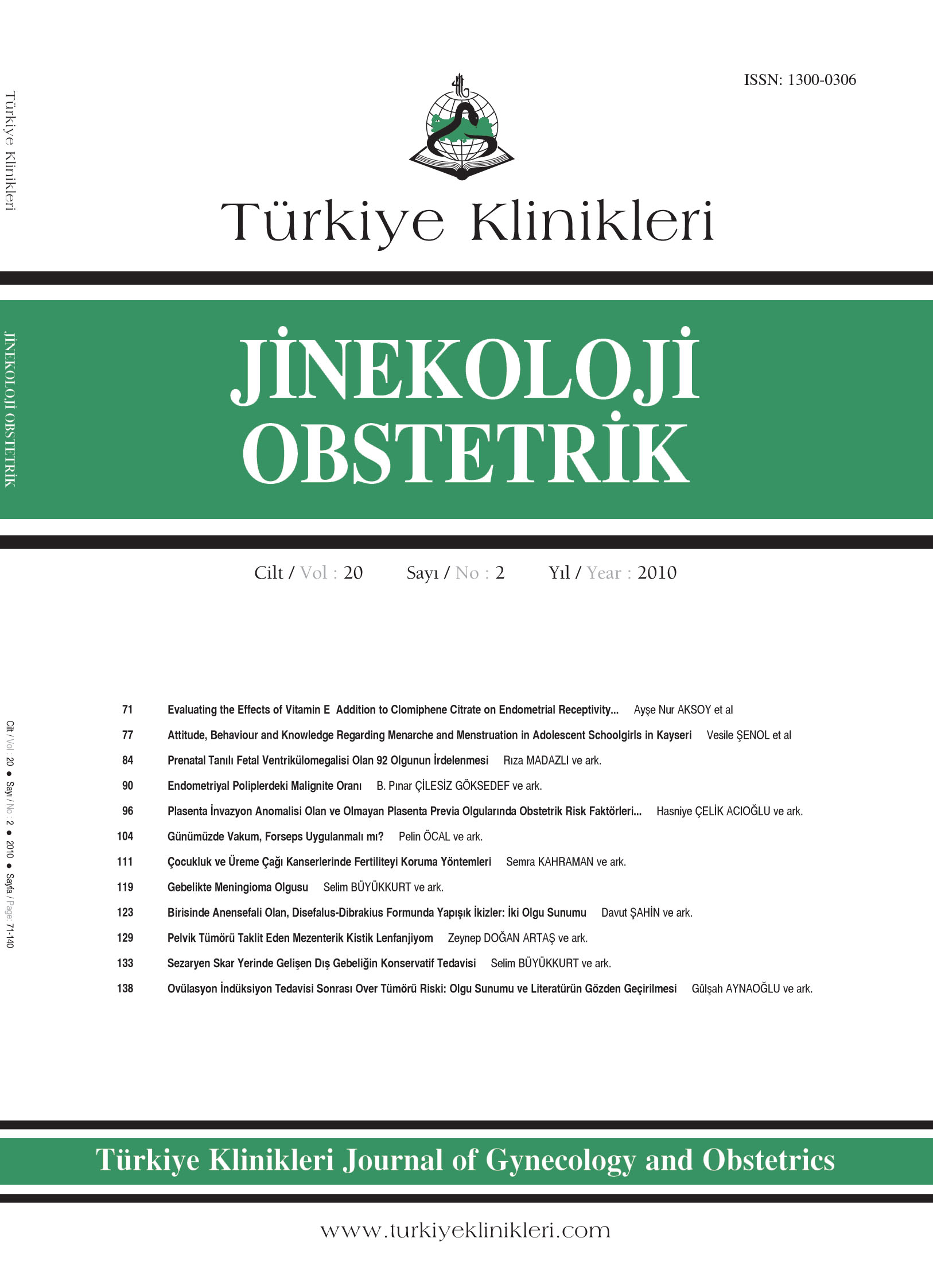Open Access
Peer Reviewed
CASE REPORTS
3300 Viewed1135 Downloaded
Conjoined Twins's Dicephalus-Dibrachius with One Has Bilateral Anencephaly: Two Case Reports
Birisinde Anensefali Olan, Disefalus- ibrakius Formunda Yapışık İkizler: İki Olgu Sunumu
Turkiye Klinikleri J Gynecol Obst. 2010;20(2):123-8
Article Language: TR
Copyright Ⓒ 2025 by Türkiye Klinikleri. This is an open access article under the CC BY-NC-ND license (http://creativecommons.org/licenses/by-nc-nd/4.0/)
ÖZET
Yapışık ikizler embriyonik diskin geç ayrışması nedeni ile oluşur. Bu çalışmada 32 ve 15 haftalık iki adet iki başlı ve iki kollu (disefalus-dibarkius) yapışık ikiz olgusu sunulmuştur. On beş haftalık fetüste bilateral anensefali olduğu izlenmiştir. Otuz iki haftalık fetusun arka mediasteninde rudimenter bir karaciğer dokusu, kalbinin sol ventrikülünden iki adet arter çıktığı, büyük bir ventriküler septal defekti ve atrial septal defekti olduğu görülmüştür. Yapışık ikizlerin oluşmasının nedeni kesin olarak bilinmemekle birlikte; etiyolojide birçok faktör etkili olabilir. Bu olgu sunumunda, yapışık ikizlerin, özelikle de anensefaliye sahip iki başlı tek gövdeli olan formunun son derece nadir görülmesi nedeni ile iki adet yapışık ikiz olgusunun anatomik ve patolojik özellikleri ve yapışık ikiz oluşumundaki etiyolojik faktörleri tartışmak amaçlanmıştır.
Yapışık ikizler embriyonik diskin geç ayrışması nedeni ile oluşur. Bu çalışmada 32 ve 15 haftalık iki adet iki başlı ve iki kollu (disefalus-dibarkius) yapışık ikiz olgusu sunulmuştur. On beş haftalık fetüste bilateral anensefali olduğu izlenmiştir. Otuz iki haftalık fetusun arka mediasteninde rudimenter bir karaciğer dokusu, kalbinin sol ventrikülünden iki adet arter çıktığı, büyük bir ventriküler septal defekti ve atrial septal defekti olduğu görülmüştür. Yapışık ikizlerin oluşmasının nedeni kesin olarak bilinmemekle birlikte; etiyolojide birçok faktör etkili olabilir. Bu olgu sunumunda, yapışık ikizlerin, özelikle de anensefaliye sahip iki başlı tek gövdeli olan formunun son derece nadir görülmesi nedeni ile iki adet yapışık ikiz olgusunun anatomik ve patolojik özellikleri ve yapışık ikiz oluşumundaki etiyolojik faktörleri tartışmak amaçlanmıştır.
ANAHTAR KELİMELER: Anensefali; ikizler, bitişik
ABSTRACT
Conjoined twins are formed by the late separating of the embryonic disc. We report two cases 32 and 15 weeks of gestation, each one has two heads and two arms (dicephalus-dibrachius). The case which had been diagnosed at 15 weeks of gestation had also bilateral anencephaly. Autopsy of the 32 weeks's fetus revealed a rudimentary liver in the posterior mediastinum, a large ventricular and atrial septal defect as well as two arteries arising from left ventricule. Although the exact cause of conjoined twins has still to be not explained, multiple factors may play role in the etiology. As conjoined twins, and especially those with bilateral anencephaly have been very rarely reported, we aimed to present the anatomical and pathological findings of two conjoined twins and to discuss the implicated etiological factors of their development.
Conjoined twins are formed by the late separating of the embryonic disc. We report two cases 32 and 15 weeks of gestation, each one has two heads and two arms (dicephalus-dibrachius). The case which had been diagnosed at 15 weeks of gestation had also bilateral anencephaly. Autopsy of the 32 weeks's fetus revealed a rudimentary liver in the posterior mediastinum, a large ventricular and atrial septal defect as well as two arteries arising from left ventricule. Although the exact cause of conjoined twins has still to be not explained, multiple factors may play role in the etiology. As conjoined twins, and especially those with bilateral anencephaly have been very rarely reported, we aimed to present the anatomical and pathological findings of two conjoined twins and to discuss the implicated etiological factors of their development.
MENU
POPULAR ARTICLES
MOST DOWNLOADED ARTICLES





This journal is licensed under a Creative Commons Attribution-NonCommercial-NoDerivatives 4.0 International License.










